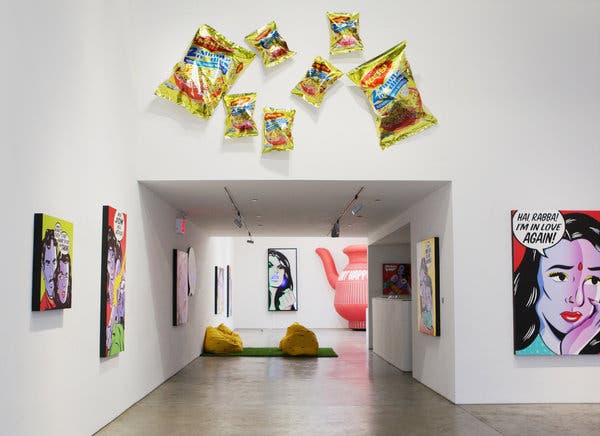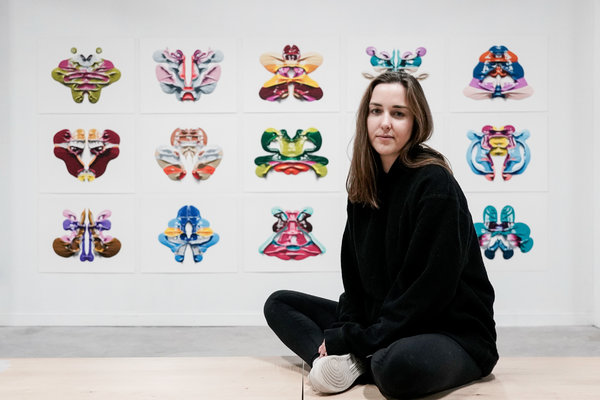A 10-foot-tall inflatable red lota, a wall covered with balloons resembling bags of Maggi noodles, and a painting of an angry bindi-wearing woman declaring “Mera jism, mera hathyar!” These works of art at Maria Qamar’s exhibition, “Fraaaandship!,” at Richard Taittinger Gallery feel like her colorful, politically engaged Instagram feed brought to life.
Her Pop art paintings — purple-skinned women, jet-black manes, yellow or red backgrounds — nod to Roy Lichtenstein and Andy Warhol. But the text emblazoned on the works in comic-style thought bubbles are intended to be inside jokes about her experiences as a South Asian millennial, contemplating immigration, misogyny, gender stereotypes and more.
“I love that she doesn’t translate her work,” said Jenna Ferrey, the gallery’s researcher and business development strategist, who helped bring Ms. Qamar into its roster of artists. “It comes very much from her point of view, her perspective, and unapologetically so.”
For the record, a lota is a water vessel used as a bidet in many Asian households; Maggi is a brand of instant noodles and seasonings that remains popular in India, Pakistan and Bangladesh; and “mera jism, mera hathyar!” translates to the battle cry “my body, my weapon!”
Ms. Qamar’s solo show is her first in New York City after signing with Richard Taittinger. At 29, she is the gallery’s youngest artist, and its first to have initially found fame on Instagram, where she has more than 170,000 followers. (She has said that her account handle, @hatecopy, refers to her time working as a copywriter.) Ms. Ferrey said she pitched representing her, partly as a way to help the gallery draw in a younger, more diverse crowd.

CreditMary Inhea Kang for The New York Times
Ms. Qamar, a Pakistan-born Canadian, started her artistic career about four years ago after she was fired from a corporate job and decided to share some of her doodles on Instagram. Her first was of a sobbing woman distressed by the fact that she “burnt the rotis,” with the caption “what if Lichtenstein parodied Indian soap operas.”
For much of her audience, Ms. Qamar’s appeal is not just in the familiarity of her work — the Hinglish (a mix of Hindi and English) they grew up using or the presence of brands and accessories they know — but also in its powerful themes. She has collaborated with Nike and the Asian music streaming app Saavn, and her work has appeared in Mindy Kaling’s “The Mindy Project.” She has also written a book, “Trust No Aunty,” and designed a set of plates.
These are edited excerpts from a conversation about her childhood in Canada, Indian soap operas and art as therapy.
What themes were you trying to explore with this solo exhibition?
I’m still dealing with [comments] like: “You can’t do that because that’s our tradition.” “We don’t wear that.” “We don’t talk like that.” “We don’t look like that.”
What part of our [South Asian] tradition is tradition and what part of our tradition is just patriarchy disguised as tradition? Why can’t we just take this time now to ditch some of these traditions that are just used to police women and used to convince women to police each other.
I want us to exhaust some of these topics — I want us to talk about them so much that we’re tired of talking about them. That’s how I want us to progress. If we can’t learn to love ourselves, in the wise words of RuPaul, “How the hell you gonna love anybody else?”
What drives you and where do you get your inspiration from?
We moved to Canada in 2000, a year before 9/11. Being called a terrorist, a Paki — direct racism and the violence that stems from it was a huge surprise for me. I grew up feeling like I did something wrong.
The documentation of what was going on started when I was experiencing real trauma, real pain, which for a kid is a lot to deal with. And how do you express that? I had art.
It was always my therapy: things that I wanted to say, things that I could’ve said. It was my way of creating a reality in which I was the one getting the last laugh.
Why don’t you translate your art?
I want to normalize what I was made to feel ashamed of. I want to continue talking about the things that I never got to talk about.
By doing this I’ve found a community and I’ve found men and women just like me — we’ve all had the same experiences yet we felt so isolated. We weren’t talking to each other about these kinds of experiences. As public as it all is now, everything is still personal, all the work is personal.
What’s your process like?
A lot of people don’t know that I paint and draw, physically, pen to paper. I actually had to teach myself Photoshop and Illustrator in order to make things for the digital space because painting takes a long time.
Your paintings look a lot like stills from Indian soap operas. Is that deliberate?
The reason I made “I burnt the rotis” in the first place was because I realized that if you take a still from an Indian soap opera when it’s zoomed in on somebody’s face and you take a Roy Lichtenstein piece and you put them side by side, it’s the exact same expression — but it’s coming from two opposite ends of the planet.
I decided to merge the two because it kind of described who I was as a person — I’m not one or the other. I don’t have to choose.
Fraaaandship!
Through Sept. 2 at Richard Taittinger Gallery, 154 Ludlow Street, Manhattan; richardtaittinger.com.









